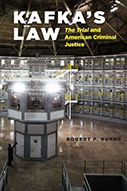Kafka’s Law: The Trial and American Criminal Justice

Author: Robert P. Burns
Publisher: Chicago, IL: University of Chicago Press, 2014. 192p.
Reviewer: Albert W. Dzur | January 2015
Robert Burns, author of A Theory of the Trial (Princeton, 1999) and The Death of the American Trial (Chicago, 2009), has a well-developed perspective on the place of the jury trial in the American legal system. The jury trial powerfully combines the formal rules and practices of the courtroom with the informal capabilities of the official non-officials, the jurors. As the prosecutor and defense attorney present competing narratives to be resolved, lay citizens are called to attend carefully to the specific person being tried, the concrete facts of the case, and the applicable laws allegedly violated. In a well-tried case, the clarifying power of the dialogue matters, as arguments move back and forth and jurors are open to being persuaded by the best account. Lamentably, this ideal is not reality. As Burns and other scholars point out, nearly all the business of criminal justice is now done behind closed doors. Fewer than five percent of criminal cases go to trial, with the vast majority disposed of via plea bargaining. While normatively central to criminal justice, the trial jury has become eclipsed by a more bureaucratic system.
While the contours of both the problem—the bureaucratization of the criminal justice process—and the solution (spoiler alert!)—greater use of the jury trial—are familiar from Burns’ previous work, what is new in Kafka’s Law is the heightened critique of contemporary practices conveyed by his alarming comparison with the hallucinatory legal realm that torments and ultimately annihilates Josef K. In The Trial, the law appears to be unknowable: neither the laws governing the trial process nor the particular charges brought against Josef K. are ever clarified. Though unknowable, the law is also ubiquitous: everywhere he goes, Josef K. encounters officers, magistrates, investigators, fellow defendants, and others in service to or in the grip of the mysterious process. Legal institutions in this oppressive domain are staffed by functionaries who themselves lack freedom even as they dominate the lives of the defendants before them. Despite the multiplicity of formal rules, the bureaucratic process entangling Josef K. is highly informal: bribes, personal connections, random events, and pressures behind the scenes may be exerting compelling force on decisions. Josef K. faces deception by court professionals and has no effective defense counsel as a counterbalance to the process that appears to be pushing him to a dreadful end. Showing no apparent interest in the concrete facts of his specific legal case, the system that has seized Josef K. nevertheless claims the right to judge his entire character, taking on a quasi-spiritual authority over life and death. Far from a fallible human institution, the legal realm is marked by a terrifying kind of necessity and inevitability.
With skillful concision, Burns reveals that all the nightmarish elements that make the novel’s reader shudder at Josef K.’s legal experience in fact characterize American criminal justice today. Focusing on the actual norms governing police searches, seizures, interrogations, and confessions, Burns demonstrates that the law on the books bears little resemblance to how the contemporary process works. He notes, too, the explosion of criminal law: “There are at least three thousand federal crimes (and probably many more), hidden in the twenty-seven thousand pages of the US Code….The ordinary citizen and even most professionals cannot know the reach of the criminal law” (80-1). As for Josef K., the law is everywhere: most adult Americans have committed a punishable offence sometime, possibly without recognizing it. Those unfortunate enough to be charged with a criminal offence in the US confront agonizingly bureaucratic police departments, prosecutors’ offices, and judicial proceedings. Like Josef K.’s process, American criminal justice operates surprisingly informally. (I write “surprisingly,” because critics of the jury often complain about the way this lay body injects informality and unwarranted discretionary power into a purportedly professional and rule-bound institution. Their complaints are misplaced: it is discretionary power all the way down.) Burns describes a number of heinous examples of police deception and bullying during interrogation as well as cases of overly aggressive prosecutorial tactics all pressed forward by the inexorable imperative to chalk up “wins.” Defendants are significantly outmatched in this process, with limited access to counsel before interrogation and then later, with attorneys hindered by restrictive evidentiary doctrines. Burns indicates, too, how sloppy fact gathering is the rule not the exception: “There is in the United States today no systematic and effective attempt to obtain and present the very most reliable evidence in criminal cases” (106). Even so, criminal justice institutions wield significant (and counter-democratic) power, blocking out as subalterns whole sections of society such as sex offenders and three-strikes recidivists. Finally, Burns holds that American criminal justice, influenced by “get tough” punitive moralism has taken on a quasi-divine status as a primary source of social order in an insecure time.
Where and how to go from here? Burns suggests we start with sober realism: major social forces have formed our criminal justice system, best seen, realistically, as “a system of police interrogation followed by plea bargaining” (65). The increasingly neoliberal rationality of government institutions, the economic insecurity and racial fears of many white Americans, and the rise in violent crime in the last half of the 20th century have all played important background roles in shaping an all-too-Kafkaesque process—although the American Josef K. is likely to be a black rather than white citizen caught up in a cycle of inevitable and inextricable domination. None of these social forces is easy to combat and each has a complex and entrenched history. Yet Burns, in my view, points in the right direction. He argues for increased formality of police procedures like interrogation, greater transparency throughout the process, and more public participation—via community policing and community prosecution. Appellate courts and legislatures must shore up the jury trial and police and prosecutors must support rather than undermine it: “more cases have to get to trial, and trials themselves have to be far less bureaucratized” (137). Progress in these areas depends greatly on public education and concomitant democratic pressure for change.
This is a compelling set of arguments. Yet Burns takes perhaps too cautious a tone in his otherwise excellent book: let us be hopeful, he says, but not optimistic about reforming such a massively dysfunctional system. Burns struggles to find solid ground in his quest for change: the public is not yet reflective enough or sufficiently educated, formal political institutions are ensnared in interest-group power-plays and beholden to an uninformed electorate, and the legal institutions themselves are trapped in the toxic bureaucracy we have just described. I disagree with his characterization of public ignorance. By his own account, lay citizens have been kept largely outside these harsh, byzantine, and deceptive institutions, and, unless swept up in them as defendants, are spectators rather than participants. Supporters of the jury trial, holding good evidence of the juridical capacity of everyday citizens, typically have more faith in lay ability and public knowledge than Burns displays here. This is not the place, though, to argue the point. Rather, let me suggest he cast his bucket down where he is and challenge our colleagues in the legal profession: legal academics, practicing attorneys, prosecutors, judges, and the majority of American legislators who are trained as lawyers. One pervasive theme in The Trial Burns does not write much about is the relentless careerism Josef K. embodies and encounters in all the professional domains touched by his work and trial. There is always a higher office, greater prestige, more status to obtain on this never ending and ultimately meaningless quest that defines the lives of the seemingly best and brightest. If conventional practices repel reflection and reinforce callous self-promotion, then it is time to figure out new ways to think about legal professionalism and new modes of training for it.
Hannah Arendt wrote that Kafka “was not fond of the world as it was given to him . . . . He wanted to build up a world in accordance with human needs and human dignities, a world where man’s actions are determined by himself and which is ruled by his laws and not by mysterious forces emanating from above or from below.” (“Franz Kafka: A Revaluation,” Partisan Review, 11 (1944): 421.) I think Burns would find many colleagues equally disgusted with the institutions they are perpetuating just by working in them. Surely it is the responsibility of legal professionals to say “No!” in whatever way they can, to the Kafkaesque practices they are reproducing every day. Legal academics in particular—standing as gatekeepers to the profession by accepting neophytes into their programs, training them, and then certifying them as practitioners—may have more influence than they know.
Albert W. Dzur, Departments of Political Science and Philosophy, Bowling Green State University


